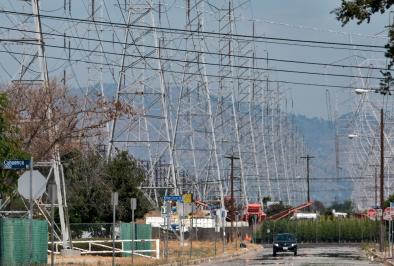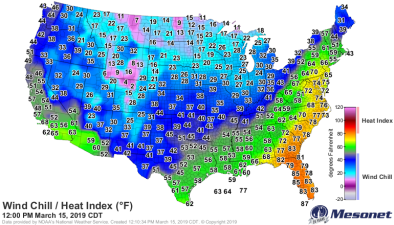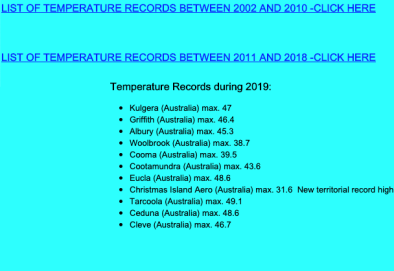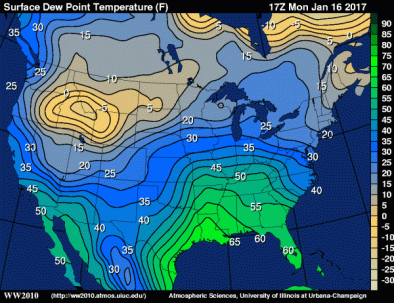
Heat-Related Illness Increase
Exposure to extreme heat is already a significant public health problem and the primary cause of weather-related mortality in the U.S.[1] As temperatures continue to increase due to climate change, heat-related illness is expected to worsen.
The atmosphere can also hold more water, reducing our bodies’ ability to cool off and increasing our risk of heat-related illness. The Heat Index, also known as the "real feel" temperature, is a measure of how hot it really feels when relative humidity is factored in with the actual air temperature.
Read More








Climate science at a glance
- Challenges to human and livestock health are growing due to the increased frequency and intensity of high temperature extremes that cause heat-related illness.[1]
- Heat stress can exacerbate preexisting health conditions and lead to an increase in human mortality.[2][3]
- As air warms, its capacity to hold water vapor increases, and measurements show that atmospheric humidity is increasing around the globe, consistent with a warming climate.[1]
- The fingerprint of climate change has been found in the increase of wet bulb temperature since 1973, driving heat stress globally.[4]
Background information
What is the Heat Index?
The National Weather Service uses a measure called “maximum heat index“—which takes into account both air temperature and humidity to calculate how hot it truly feels outside—to warn people of extreme heat. The group typically issues a “heat advisory” when a maximum heat index is expected to hit at least 100°F for two or more days, and an “excessive heat warning” when it will hit at least 105°F for two or more days. At these levels, prolonged heat exposure can lead to health risks including dehydration, worsening of chronic conditions, and heat stroke, especially for children and the elderly.
What is relative versus specific humidity?
Specific humidity increases as the climate warms. It is an absolute measure of the amount of water in a given amount of air. Just as the absolute amount of water in a given amount of air increases as the climate warms, the amount of water the air can hold increases. Relative humidity looks at how much water is in the air relative to how much could be in the air. This ratio—between how much water is in the air versus how much the air could hold— is expected to remain constant as the climate warms.
What is "wet-bulb temperature"?
Instead of simply looking at the thermometer to see how hot it is, a wet-bulb temperature is taken by first wrapping the bulb of a thermometer in a wet cloth – hence, “wet bulb”. Wet-bulb temperature accounts for both heat and humidity. It reflects what that combination means for the human body’s ability to cool down.
“The idea here is that you and I are essentially wet bulbs. We cool ourselves by evaporation. If the wet-bulb temperature reading is higher than our body temperature, that means that we cannot cool ourselves to a temperature tolerable for humans by evaporating sweat, and that basically means you can’t survive,” said Tapio Schneider, a California Institute of Technology climate scientist and professor.
As the globe warms and water evaporates at higher rates than before, raising humidity levels, wet bulb temperatures will continue to rise.
U.S. humidity and heat-related illness trends and climate change
- (NCA 4, 2018): Elevated temperature, combined with increased salinity and humidity, accelerates deterioration in bridges and roads constructed with concrete.[1]
- (Feng et al. 2016): Absolute humidity is increasing significantly in the Midwest,[6] creating favorable conditions for pests and pathogens and degrading the quality of stored grain.[1][7]
- (Brown and DeGaetano, 2013): In the Midwest, daily minimum temperatures have increased in all seasons due to increasing humidity.[7]
- (Karl et al. 2008): Increasing humidity is contributing to higher nighttime temperatures in the U.S.[5]
U.S. studies attribute increased humidity and heat stress to climate change
- (Lehner et al. 2018): Warming in the southwestern U.S. is largely due to greenhouse gas forcing.[8]
- (Diffenbaugh et al. 2017): The study formally identifies the influence of anthropogenic warming in the observed trend of increasing heat extremes over the western U.S.[9]
- (Shiogama et al. 2014): Anthropogenic warming made a severe heat wave that occurred in the southwestern United States during June and July 2013 more likely.[10]
- (Diffenbaugh and Scherer, 2013): Extreme July temperatures like those observed in 2012 are more than four times as frequent over the north-central and northeastern United States due to anthropogenic climate change.[11]
- (Morak et al. 2011): Human-caused climate change is at least partly responsible for a strong increase in the number of warm nights in western North America.[12]
Global humidity and heat stress trends and climate change
- (Speizer et al. 2022): Humid heat extremes have intensified in most regions, with some areas having experienced greater increases than others.
- (Raymond et al. 2020): The frequency of humid heat so high it comes close to overwhelming the human body’s ability to regulate its temperature has more than doubled in some coastal subtropical regions of the world since 1979.[13]
- (Grumm and Balogh, 2016): The northern hemisphere has had increasingly warmer and more humid summers, and the global area covered by extreme water vapor is increasing significantly.[15]
Global studies attribute increased humidity and heat stress to climate change
- (IPCC AR6, 2021): "Global total column water vapour content has very likely increased since the 1980s, and it is likely that human influence has contributed to tropical upper tropospheric moistening. Near-surface specific humidity has increased over the ocean (likely) and land (very likely) since at least the 1970s, with a detectable human influence (medium confidence)." (Technical Summary, p. 51)
- (Wehner et al. 2018): The study looks at increases in the frequency and intensity of extremely hot three day periods due to human-caused climate change. The authors find that the shift in the distribution of surface air temperature since the mid 20th century has been profound and most regions have experienced increases in the frequency an intensity of extremely hot three day periods. Temperatures that were rare prior to the 1980's now occur with regularity.[16]
- (Diffenbaugh et al. 2017): Anthropogenic global warming had a significant hand in the temperatures seen during the hottest month and on the hottest day on record throughout much of the world from 1931–2016. They find that the global trend in warming contributed to the record for hottest day of the year in at least 82 percent of the records over the 1961-2010 period.[9]
- (Knutson and Ploshay 2016): There has been a detectable human-caused increase in mean summertime heat stress since 1973, both globally and in most land regions analyzed.[4]








